How emotionally aware are you?
I’d like you to spend a minute or so thinking about the last 24 hours. Really think about it. How was it for you? Now write down as many feelings as you can recall experiencing during that time.
If you are struggling, try using the feelings wheel to help you.
How many were positive experiences versus negative ones? Is that a typical ratio for you? What might be the ratio of positive to negative experiences that your friends, family or colleagues are having right now? What sort of outcomes are you seeing from those experiences? Frustration? Overwhelm?
Why we react the way we do
Think of your brain as a house, with people living on both floors. The people living downstairs signal what emotions we are experiencing, and they also keep us safe by being on the lookout for danger. The upstairs floor is where the thinking people live. They help us understand our emotions, to decide how to behave and to solve problems. Everything works in harmony when the people on both floors talk to one another and work together.

But the downstairs floor sometimes takes over. This may be because it senses danger, or gets overwhelmed with a feeling, such as fear or excitement, and makes it hard for us to think. This is called ‘flipping the lid’ – Flipping Your Lid – A Scientific Explanation.
Essentially our brain is trying to protect us, sensing danger and triggering the fight or flight response. Although our brains are trying to keep us safe, it’s not always helpful when we’re flipping our lids!
The study of positive emotions
In the mid 90’s American psychologist, Barbara Fredrickson, began studying positive emotions. Her research led to a theory called Broaden and Build. The notion is that positive emotions play an essential part in our survival. Emotions, like love, joy and gratitude promote new and creative actions, ideas and social bonds.
When we experience positive emotions, our minds broaden, opening up to new possibilities and ideas. We’re more willing to try new things, more creative and more engaged and engaging. They also help us build our personal wellbeing resources, like resilience and social support. As this broadening of our minds and building of personal resources takes place, it fosters enhanced health, survival and fulfilment, creating more experiences of positive emotions and an upward spiral.
The opposite occurs with negative emotions, our thinking becomes narrow, we close ourselves off to new possibilities and ideas, we are no longer open to building new relationships or resources, we become disengaged.
The direct link between how people feel at work and how they perform

Our emotions are not restricted to our private lives. We experience a wider range of feelings as part of our everyday working lives. Interactions with colleagues, customers and others provoke emotional responses as do the relationships we have with our mangers.
A 2011 study by Dr. Christina Boedker et al, looked at several hundred organisations in Australia and studied objective criteria to split them into High Performing and Low Performing workplaces (HPW & LPW). As part of the study they researched emotions in both.
They found positive emotions were much more commonly experienced by those working for HPW’s and conversely negative emotions were experienced more by those working in LPW’s.
The study also found that HPW’s had lower employee turnover, higher leadership capabilities, higher levels of innovation outputs and job satisfaction and their customers received a better overall experience.
How do I start my upward spiral?
The benefits of positive emotions are clear, both from a personal and organisational context so how can you go about increasing your own positive emotions to broaden your thoughts and build your personal resources? Here are six techniques to try:
- Gratitude practice – at the end of each day, make a note of three things that you are grateful for. What went well for you and why?
- Practice Mindfulness – “Mindfulness is the basic human ability to be fully present, aware of where we are and what we’re doing, and not overly reactive or overwhelmed by what’s going on around us.” There are many forms of mindfulness to try and numerous apps to help the uninitiated.
- Practice loving-kindness mediation – this is meditation for compassion, specifically placing a deliberate emphasis on directing goodwill to yourself and others. There are many good quality guided, loving kindness meditations on the popular mindfulness and meditation apps as well as YouTube.

- Reframe negative events – developing skills to cope with adversity can help us become more resilient and positive. Reivich and Shatté (2002) describe a sequence of steps you can take to examine and reframe negative events, which include:
- Identifying the type of emotion experienced
- Identifying thinking traps preventing us from seeing the bigger picture
- Putting our negative thoughts into perspective
- Taking positive action
- Create positive experiences – carry out a random act of kindness, help a friend or colleague with something, volunteer regularly, offer support to others. Creating positive experiences that are shared with others can have a lasting impact on our emotions. A far bigger impact than material things.
- Hold a good posture – when you are in immediate need of positive emotions, paying attention to your body language and adjusting it accordingly can be beneficial. Amy Cuddy’s book, Presence (2016), and her 2012 Ted talk, “Your body language shapes who you are” explain how our posture affects our emotions.
In summary
Our emotions influence our decisions, our behaviour and our performance so they are all important, pleasant and unpleasant. We can’t stop unpleasant emotions but it’s important to pay attention to how we feel and to act more intentionally with them.
Notice and intentionally act, rather than allowing our emotions to take control. You can’t stop a bird landing on your head, but you can stop it building a nest.
by Steve Brunt, Learning and Development Consultant.
















